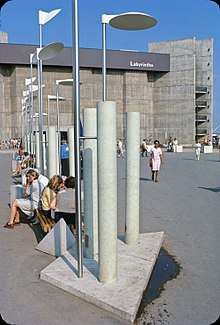In the Labyrinth (film)
In the Labyrinth (French: Dans le labyrinthe) was a groundbreaking multi-screen presentation at the Labyrinth pavilion at Expo 67 in Montreal, Quebec, Canada. It used 35 mm and 70 mm film projected simultaneously on multiple screens and was the precursor of today's IMAX format.[1]
| In the Labyrinth | |
|---|---|
| Directed by | Roman Kroitor Colin Low Hugh O'Connor |
| Produced by | Tom Daly Roman Kroitor |
| Music by | Eldon Rathburn |
| Cinematography | Michel Thomas-d'Hoste Walter Lassally Gilles Gascon Georges Dufaux V.V. Dombrovsky Alex O. Krasnov |
| Edited by | Tom Daly |
| Distributed by | National Film Board of Canada |
Release date | April 1967 (Expo 67) 1979 (single-screen version) |
Running time | 21 minutes |
| Country | Canada |
| Language | English French |
The film split elements across the five screens and also combined them for a mosaic of a single image. It was hailed as a "stunning visual display" by Time magazine, which concludes: "such visual delights as Labyrinth ... suggest that cinema—the most typical of 20th century arts—has just begun to explore its boundaries and possibilities."[2]
In the Labyrinth was co-directed by Roman Kroitor, Colin Low and Hugh O'Connor and produced by the National Film Board of Canada. Kroitor left the NFB shortly after to co-found Multi-Screen Corporation, which later became IMAX Corporation.[3]
NFB animator Ryan Larkin also designed animated sequences for the film.[4]
It inspired Canadian filmmaker Norman Jewison to apply similar techniques to his film The Thomas Crown Affair.[5]
Labyrinth pavilion

The Labyrinth was a five-storey building consisting of two screening halls and a transition hall.
Theatre One ran two 70 mm projectors in a unique floor-and-end-wall combination where audiences stood on eight balconies spread over four floors, viewing on two screens, measuring eleven-and-a-half meters by six meters each, images symbolizing the entry of man into the world, the innocence of childhood and the joie de vivre of adolescence. Two hundred and eighty-eight speakers arranged behind the screens ensured a sound experience that had been unmatched until then.
Audiences then crossed The Maze, a transitional space filled with colour and music evoking the mazes of a labyrinth, an apparently limitless series of mirrors and red "grain-of-wheat" bulbs.
They then entered Theatre Three, which projected the highlight of the show, five simultaneous 35 mm projections in a cross formation.
The pavilion cost $4.5 million and attracted over 1.3 million visitors in 1967.[3][6]
Post-1967
In 1979, the NFB re-issued In the Labyrinth in a single-screen format.[7] In May 2007, the NFB and the Cinémathèque québécoise presented an exhibition on the Labyrinth pavilion, marking the 40th anniversary of Expo 67.
From September 18 to 30, 2017, during the 50th anniversary of Expo 67, the central square of Place des Arts is the site of a multi-screen NFB installation Expo 67 Live, partly inspired by In the Labyrinth.[8]
References
- Desjardins, Cléa (28 October 2014). "Expo 67: The birthplace of modern moviegoing". Concordia University. Retrieved 30 October 2014.
- "Magic in Montreal: The Films of Expo". Time. 1967-07-07. Retrieved 2008-03-01.
- Aitken, Ian (October 27, 2005). "NFB's Labyrinth". Encyclopedia of the Documentary Film. Routledge. pp. 168–9. ISBN 978-1579584450.
- Robinson, Chris (2006). Unsung Heroes of Animation. Indiana University Press. p. 100. ISBN 978-0-86196-665-3.
- Atherton, Tony (2000-07-10). "When camera and gun collide". Ottawa Citizen. pp. D7.
- "The history of Expo 67's Labyrinth Pavilion". NFB/blog. 16 September 2017. Retrieved 27 April 2018.
- "NFB Web page". Retrieved 2008-03-01.
- Indongo, Nantali (2017-09-10). "'You want to go big': Gigantic multimedia installation brings Expo 67 to Montrealers". CBC News. Retrieved 2017-09-13.
External links
- Watch In the Labyrinth at the NFB website
- The history of Expo 67’s Labyrinth Pavilion at the NFB website
- In the Labyrinth on IMDb
- Web page for Labyrinth and film
- Labyrinth pavilion